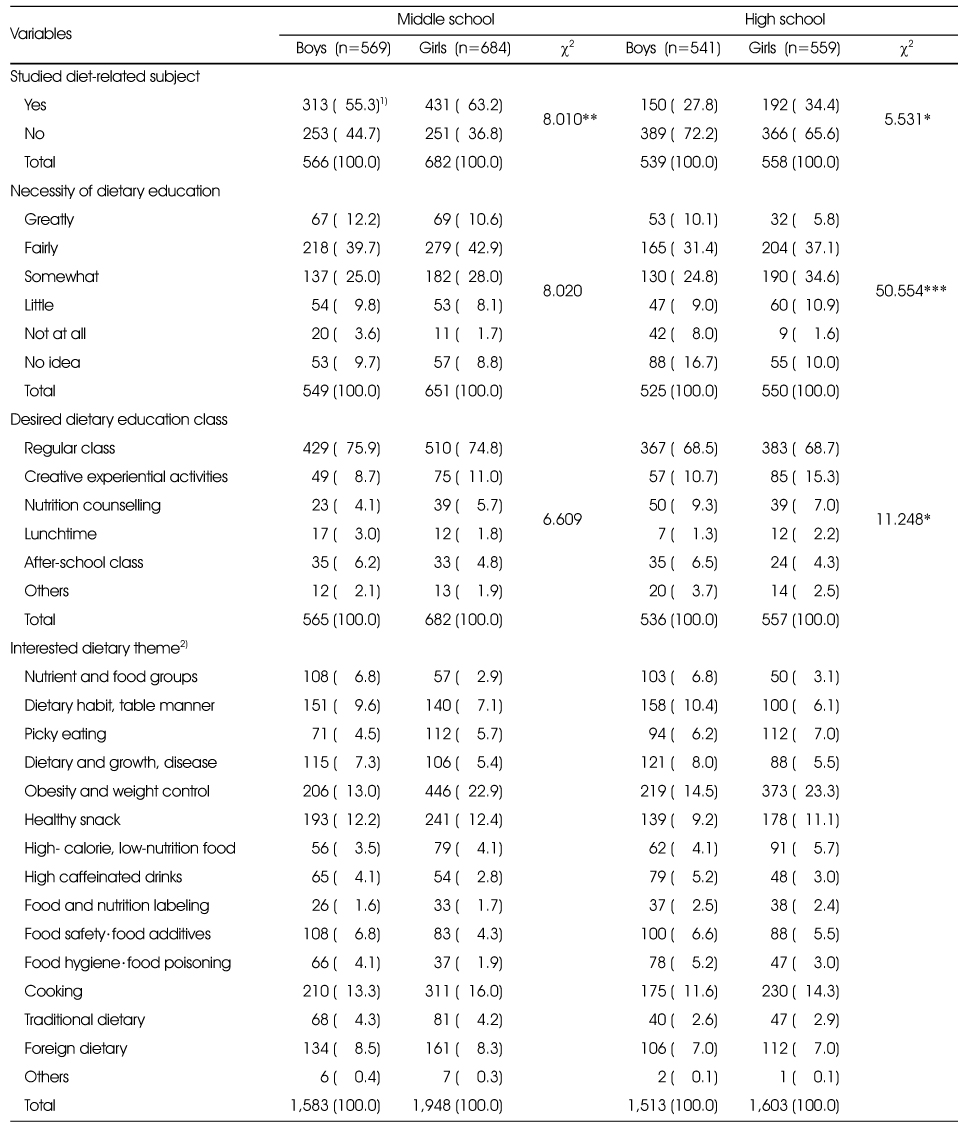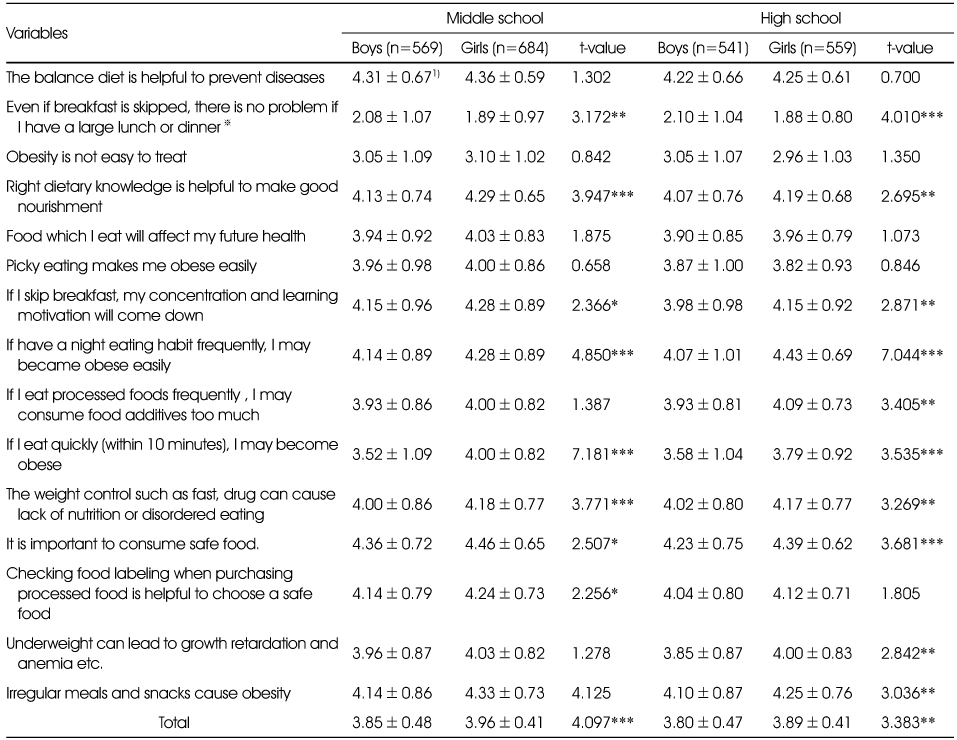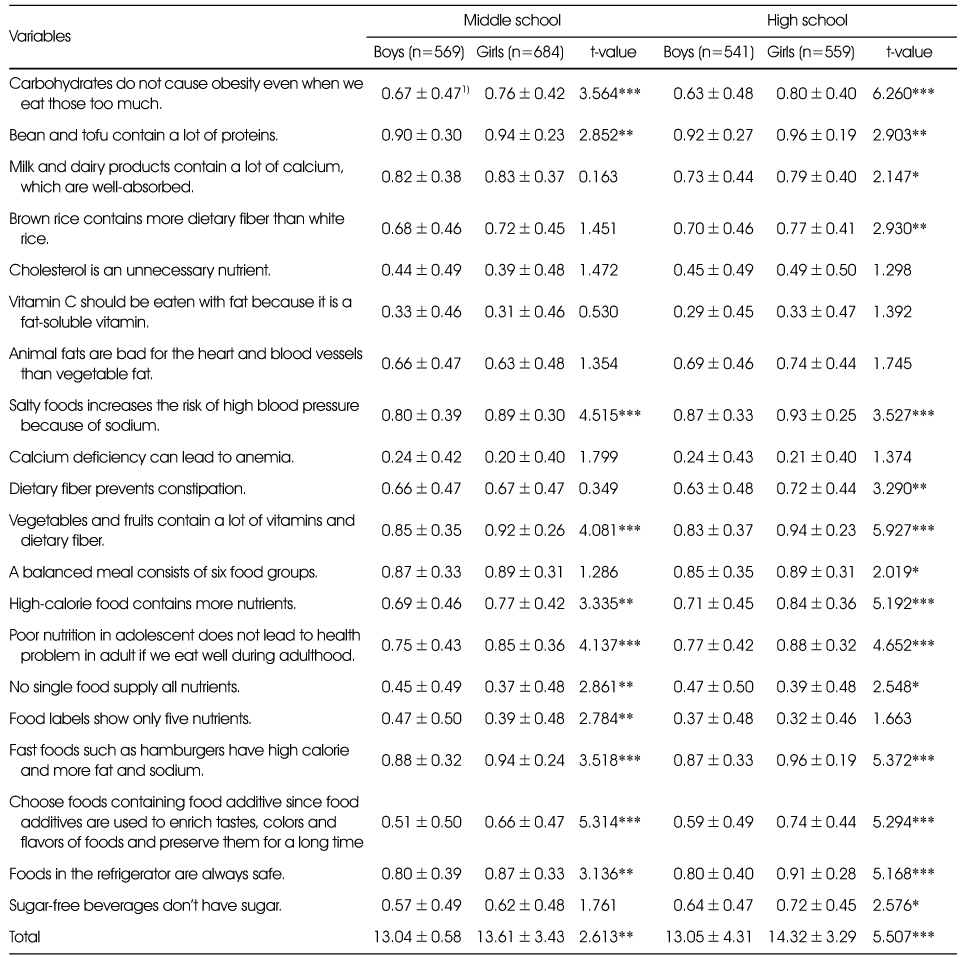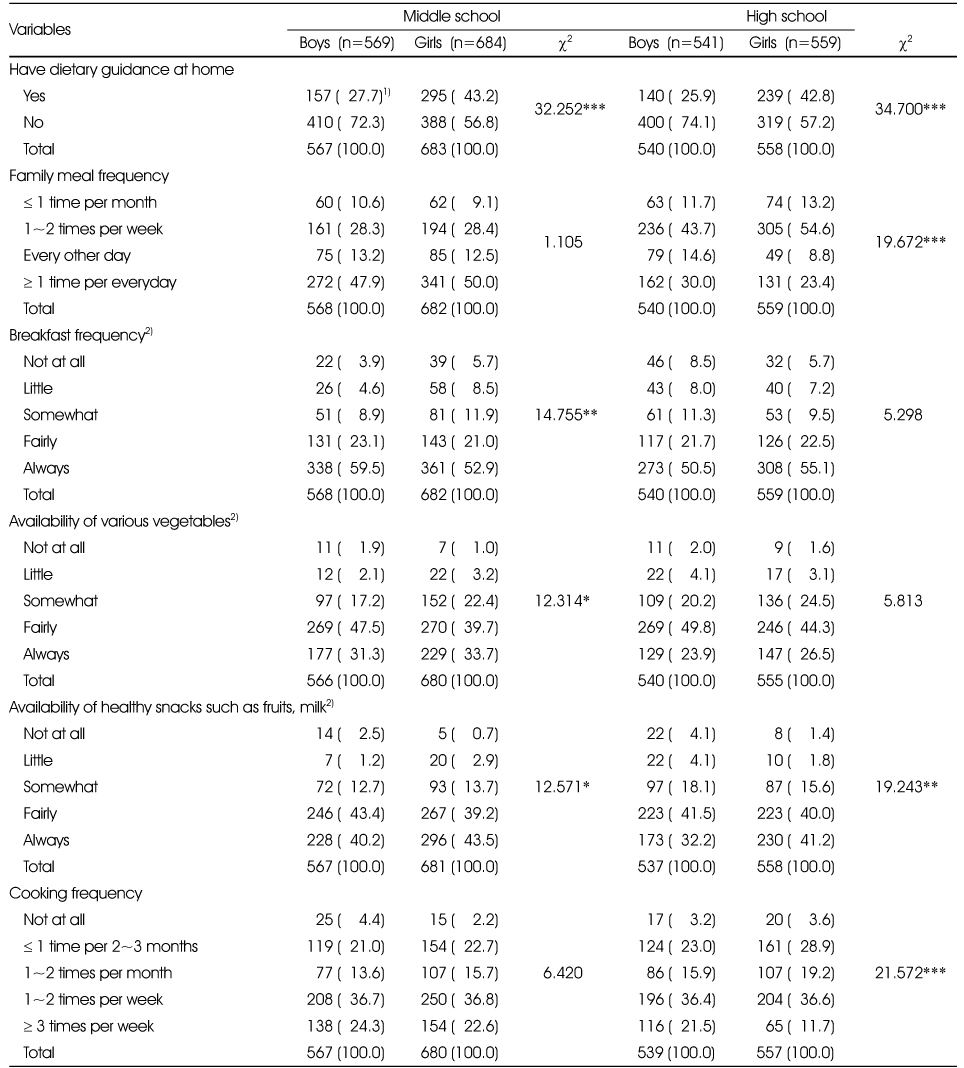References
1. Golmakani N, Naghibi F, Moharari F, Esmaily H. Health promoting life style and its related factors in adolescent girls. J Midwifery Reprod Health 2013;1(1):42–49.
2. Spratt J, Shucksmith J, Philip K, Watson C. Part of who we are as a school should include responsibility for well-being: links between the school environment, mental health and behavior. Pastor Care Educ 2006;24(3):14–21.
3. Sung CJ. A comparative study of food habits and body satisfaction of middle school students according to clinical symptoms. J Korean Soc Food Sci Nutr 2005;34(2):202–208.
4. Lee JS, Yun JW. A study on perception about body image, dietary attitude, dietary self-efficacy and nutrient intake of high school students in Busan. J Korean Soc Food Sci Nutr 2003;32(2):295–301.
5. Ministry of Health and Welfare, Korea Centers for Disease Control and Prevention. Korea Health Statistics 2014 Korea National Health and Nutrition Examination Survey (KNHANES VI-2) [internet] Ministry of Health and Welfare Korea Centers for Disease Control and Prevention; 2015. cited 2016 Jan 10. Available from:
http://knhanes.cdc.go.kr/.
6. Ministry of Education, Science and Technology, Ministry of Health and Welfare, Korea Centers for Disease Control and Prevention. 2015 Korean Youth Risk Behavior Web-based Survey [internet] Ministry of Health and Welfare Korea Centers for Disease Control and Prevention; 2015. cited 2015 Dec 29. Available from:
http://knhanes.cdc.go.kr/.
7. Lee YS, Lim HS, Ahn HS, Jang NS. Nutrition through the life cycle Seoul: Kyomunsa; 2011. p. 281.
8. Jo JE, Park HR, Jeon SB, Kim JS, Park GE, Li Y. A study on relationship between socio-demographic factors and food consumption frequencies among adolescents in South Korea. Korean J Community Nutr 2013;18(2):165–176.
9. Croll JK, Neumark-Sztainer D, Story M. Healthy eating: what does it mean to adolescents? J Nutr Educ Behav 2001;33(4):193–198.
10. Diaz H, Marshak HH, Montgomery S, Rea B, Backman D. Acculturation and gender: influence on healthy dietary outcomes for Latino adolescents in California. J Nutr Educ Behav 2009;41(5):319–326.
11. Kwak SH, Woo TJ, Lee KA, Lee KH. A comparison of dietary habits and influencing factors for vegetable preferences of adolescents in Gyeongnam province. Korean J Community Nutr 2015;20(4):259–272.
12. Bisogni CA, Jastran M, Seligson M, Thompson A. How people interpret healthy eating: contri-butions of qualitative research. J Nutr Educ Behav 2012;44(4):282–301.
13. Yang IS, Lee HY, Kim HY, Kang YH. Setting instructional goals for nutritional education program through an analysis of problems identified in junior/senior high school students. Korean J Community Nutr 2003;8(4):495–503.
14. Park SH, Park HR, Jeon SB, Jeong SY, Tserendejid Z, Seo JS. Awareness and practice of dietary action guide for adolescence among middle and high school students in Korea. Korean J Community Nutr 2012;17(2):133–145.
15. Contento IR. Nutrition education: linking research, theory and practice 3th edth ed. Massachusetts: Jones & Bartlett Learning; 2015. p. 65–66.
p. 74p. 78–79.
.
16. Chang HS, Roh SM. Comparison with dietary habits, dietary attitudes and nutritional knowledge according to sex of teenagers in Jeonnam province. Korean J Community Nutr 2006;11(4):459–468.
17. Ministry of Health and Welfare. Dietary guidelines for Korean [internet] Ministry of Health and Welfare; cited 2014 Jan 20. Available from:
http://www.mohw.go.kr/front_new/.
18. Lee EJ. A survey on the snack intake and dietary habits affected by nutrition knowledge of middle school students in Incheon [master's thesis] Inha University; 2012.
19. Kim MN. Adolescent's dietary behaviors, health interest, nutrition knowledge: Its effects on their intakes of nutritional supplements [master's thesis] Hanyang University; 2013.
20. Dewar DL, Lubans DR, Plotnikoff RC, Morgan PJ. Development and evaluation of social cognitive measures related to adolescent dietary behaviors. Int J Behav Nutr Phys Act 2012;9(36):1–10.
21. Park KS, Chun BY, Kam S, Yeh MH, Kang YS, Kim KY. Structural relationships among health concern, health practice and health status of the disabled. Korean J Prev Med 1999;32(3):276–288.
22. Breslow L, Enstrom JE. Persistence of health habits and their relationship to mortality. Prev Med 1980;9(4):469–483.
23. Lee YJ, Lee HJ, Lee KH. Effects of 16-class nutrition education on middle school students' dietary behavior and nutritional knowledge. Korean J Food Nutr 2014;27(5):826–836.
24. Kang NE, Yoon HR, Kim JH. A Study on the behavior of food hygiene and interest in dietary information according to the level of awareness and practice of food safety. Korean J Food Cult 2013;28(6):623–630.
25. Jung YH, Ko SJ, Lim HJ. The socioeconomic cost of adolescent obesity. Health Soc Welf Rev 2010;30(1):195–219.
26. Sung EJ, Shin TS. The effect of overweight to cardiovascular risk factors among Korean adolescents. J Korean Acad Fam Med 2003;24(11):1017–1025.
27. Voelker DK, Reel JJ, Greenleaf C. Weight status and body image perceptions in adolescents: current perspectives. Adolesc Health Med Ther 2015;6:149–158.
28. Ahn Y, Kim KW. Beliefs regarding vegetable consumption, selfefficacy and eating behaviors according to the stages of change in vegetable consumption among college students. Korean J Community Nutr 2012;17(1):1–13.
29. Choi MK, Bae YJ, Kim MH, In SJ. A survey of the needs of nutrition education based on analysis of eating habits and nutrition knowledge among middle school students in Kyung-Gi province. J Korean Diet Assoc 2010;16(2):133–145.
30. Choi MY, Kim HY. Nutrition knowledge, dietary self-efficacy and eating habits according to student's stage of regular breakfast or exercise. Korean J Community Nutr 2008;13(5):653–662.
31. Kim YH. A survey on the nutrition knowledge, dietary behavior and satisfaction of dietary education of high school female students. J Korean Home Econ Educ Assoc 2012;24(1):21–36.
32. Schwartz NE. Nutritional knowledge, attitudes and practices of high school graduates. J Am Diet Assoc 1975;66(1):28–31.
33. Kim BH, Sung MY, Lee YN. Comparison of the nutrient intakes by the score of dietary action guides for Korean children among the elementary school students in Gwangju city. Korean J Community Nutr 2011;16(4):411–425.







